Abstract
Human operant behavior is often said to be controlled by different variables or governed by different processes than nonhuman operant behavior. Support for this claim within the operant literature comes from data suggesting that human behavior is often insensitive to schedules of reinforcement to which nonhuman behavior has been sensitive. The data that evoke the use of the terms sensitivity and insensitivity, however, result from both between-species and within-subject comparisons. We argue that because sensitivity is synonymous with experimental control, conclusions about sensitivity are best demonstrated through within-subject comparisons. Further, we argue that even when sensitivity is assessed using within-subject comparisons of performance on different schedules of reinforcement, procedural differences between studies of different species may affect schedule performance in important ways. We extend this argument to age differences as well. We conclude that differences across populations are an occasion for more precise experimental analyses and that it is premature to conclude that human behavior is controlled by different processes than nonhuman behavior.
Keywords: humans, sensitivity, schedules of reinforcement, concurrent schedules, interspecies continuity
Full text
PDF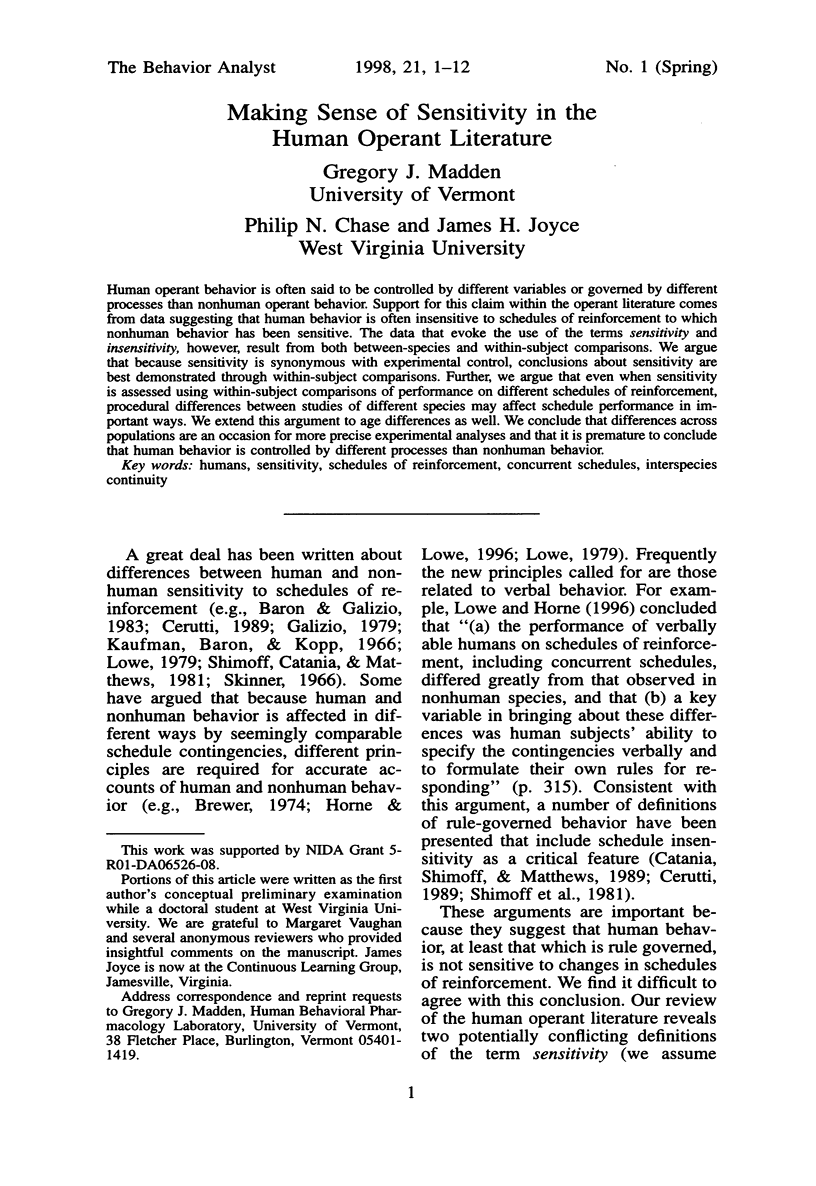
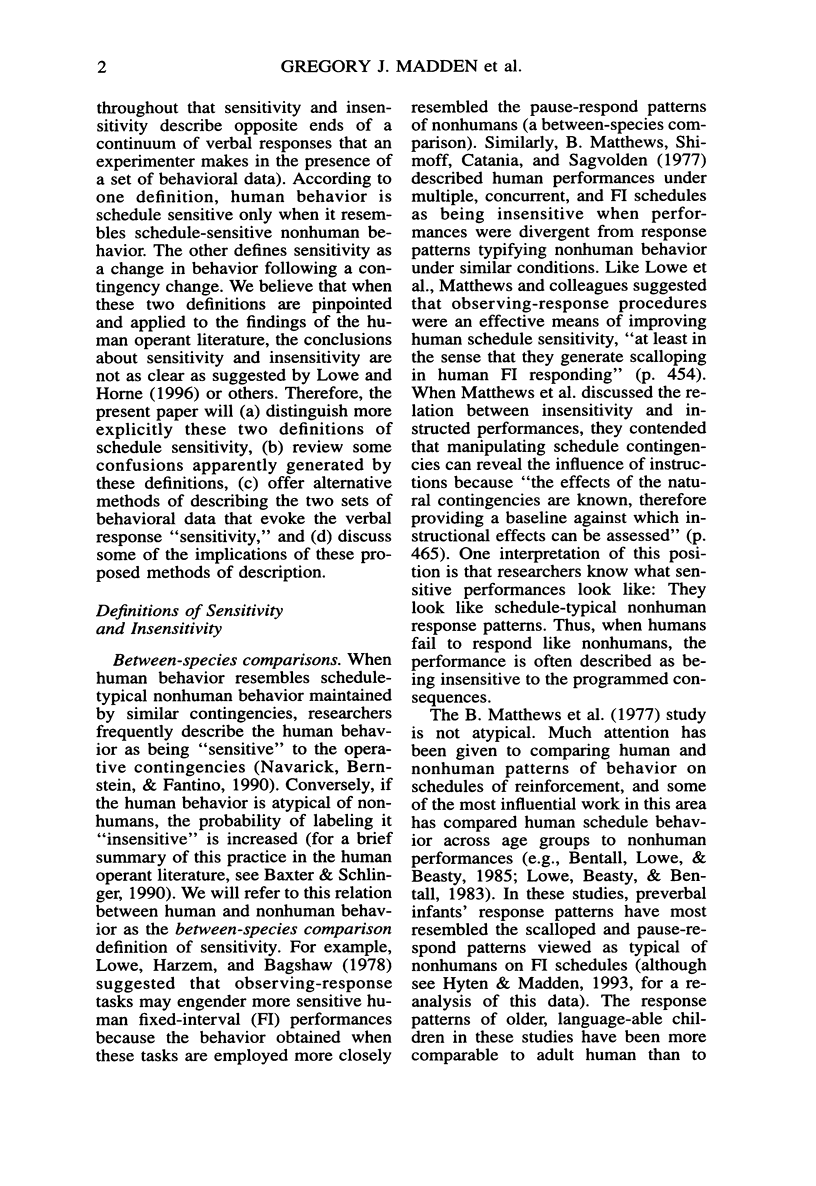
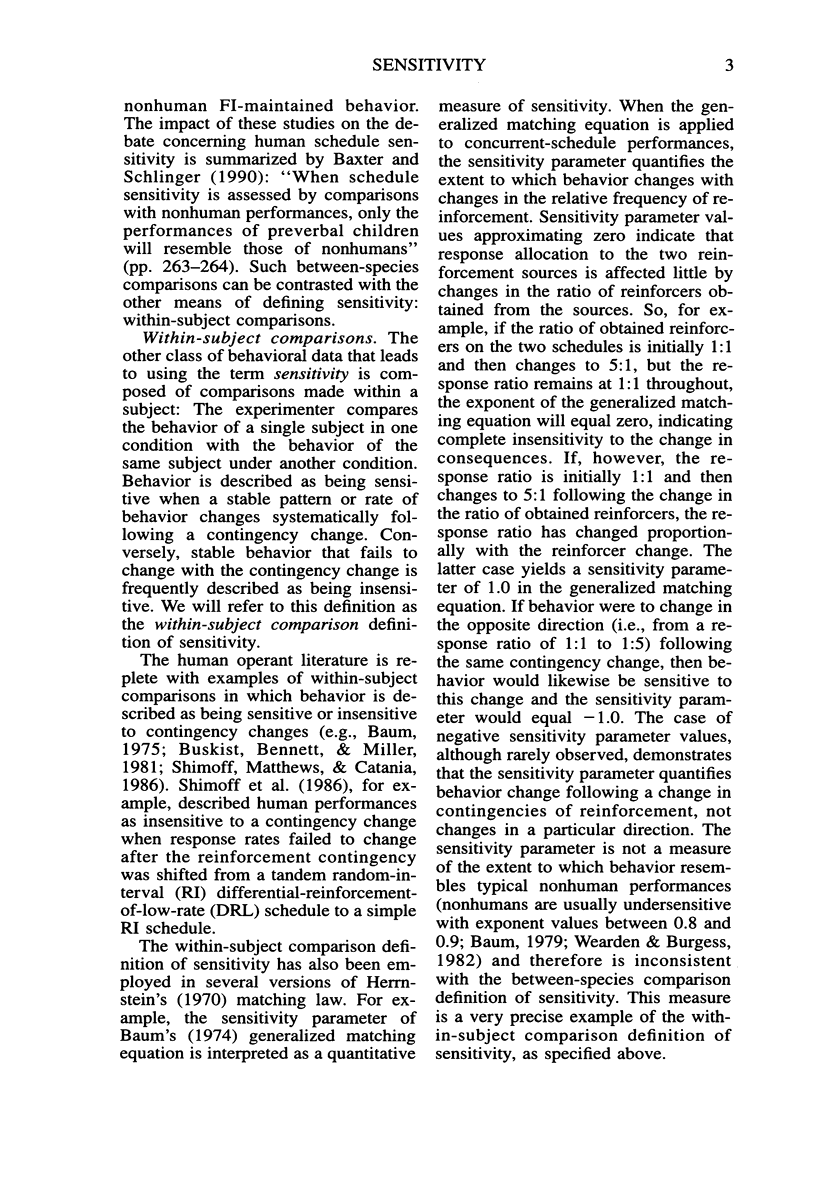
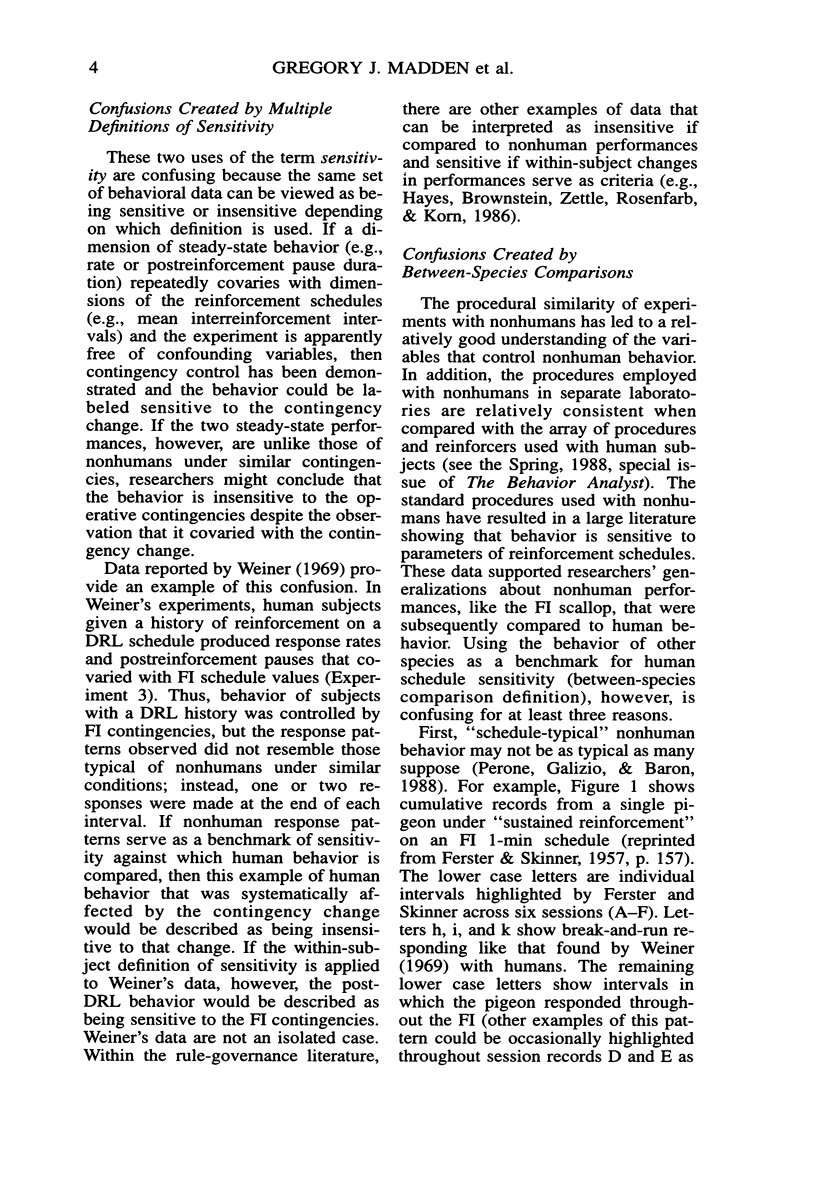
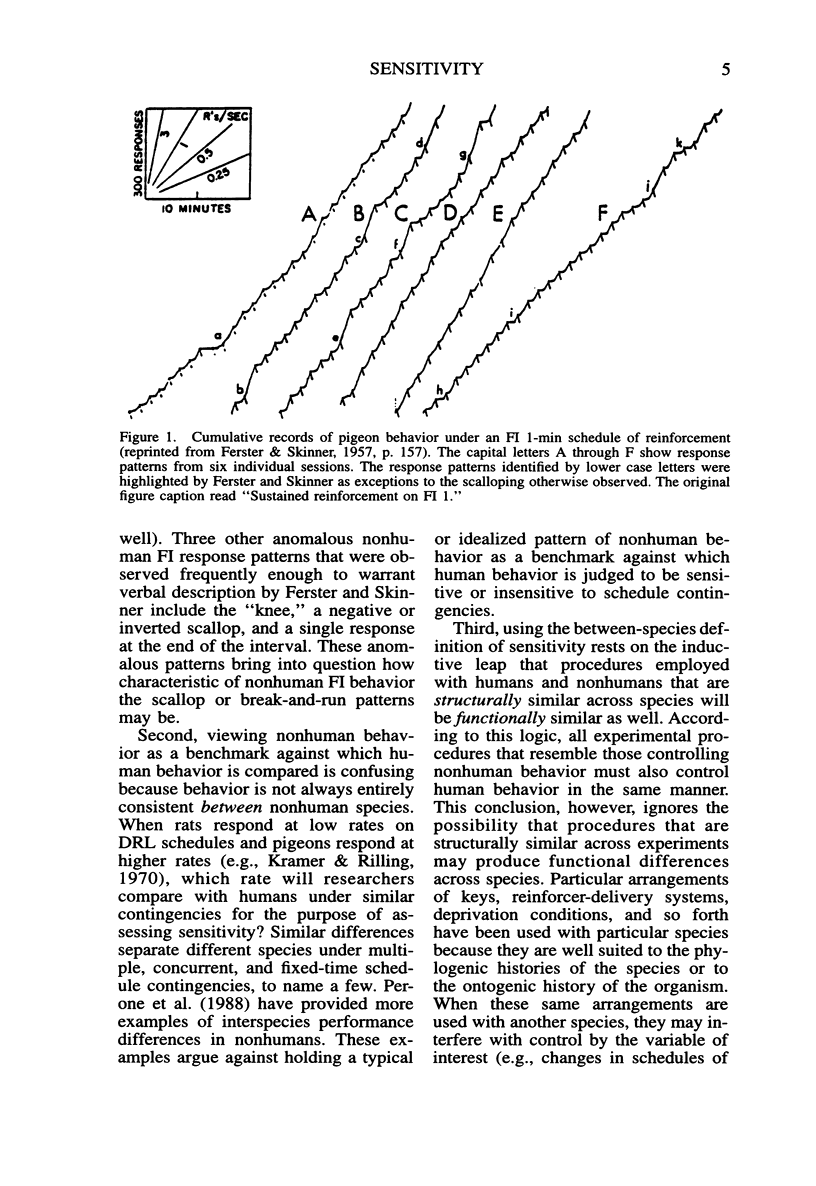
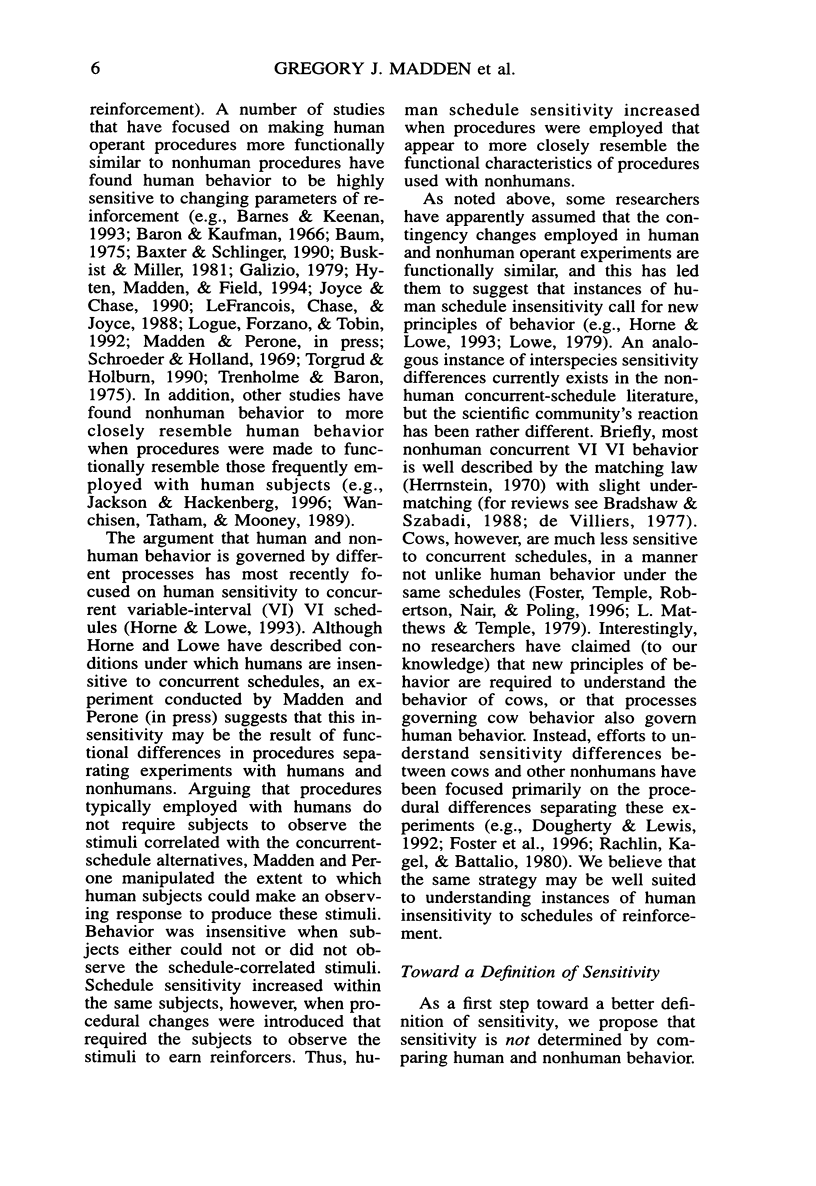
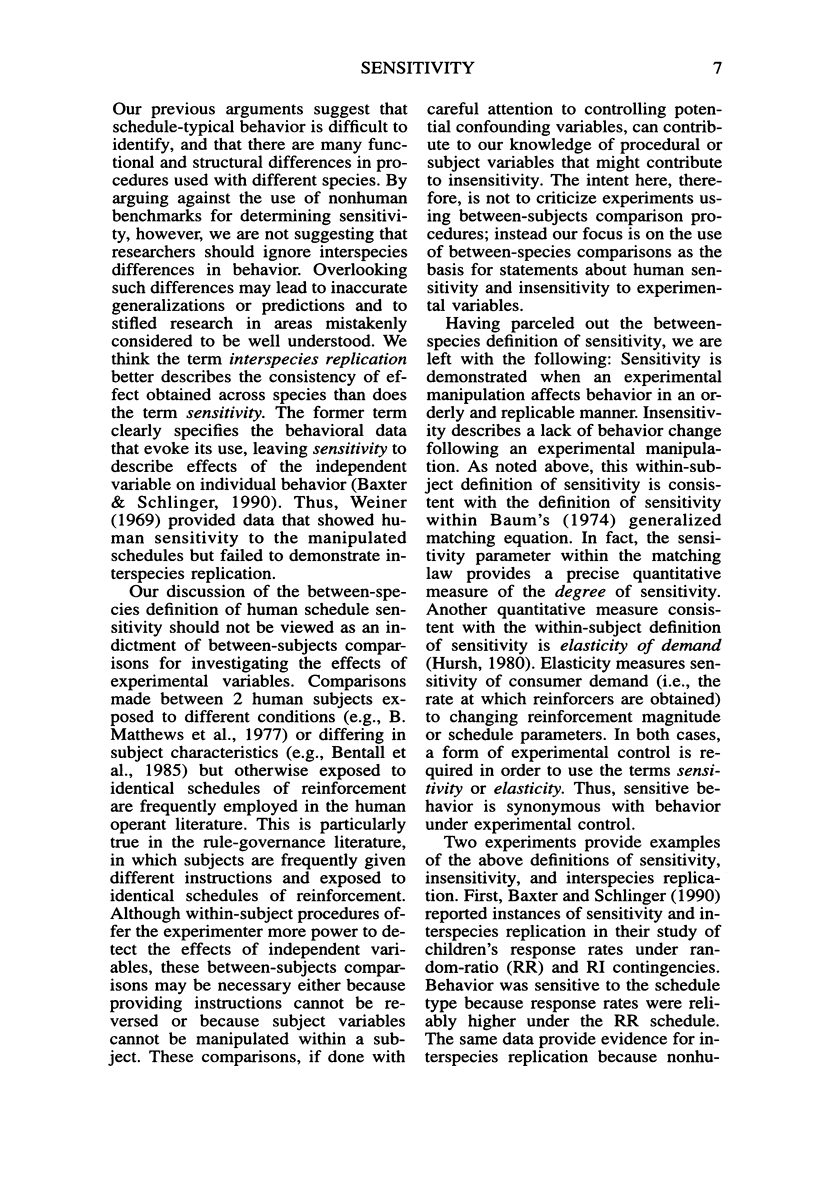
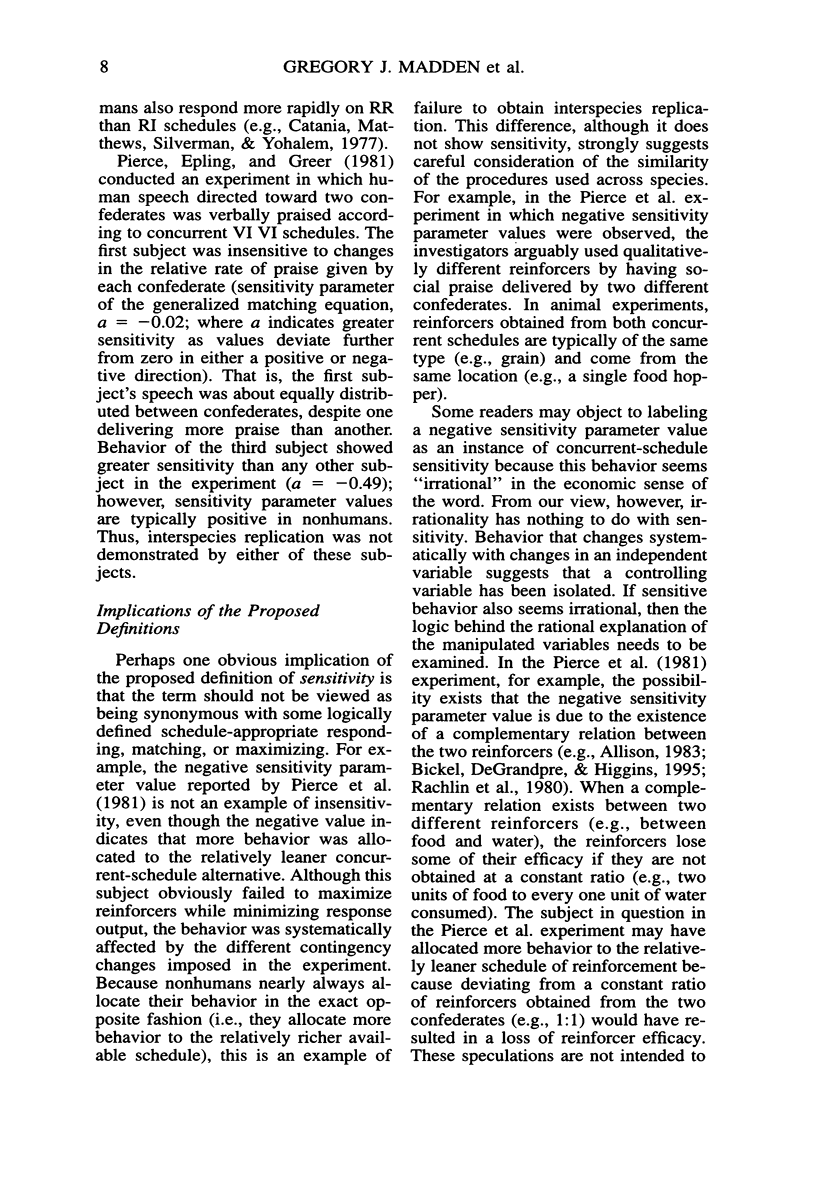
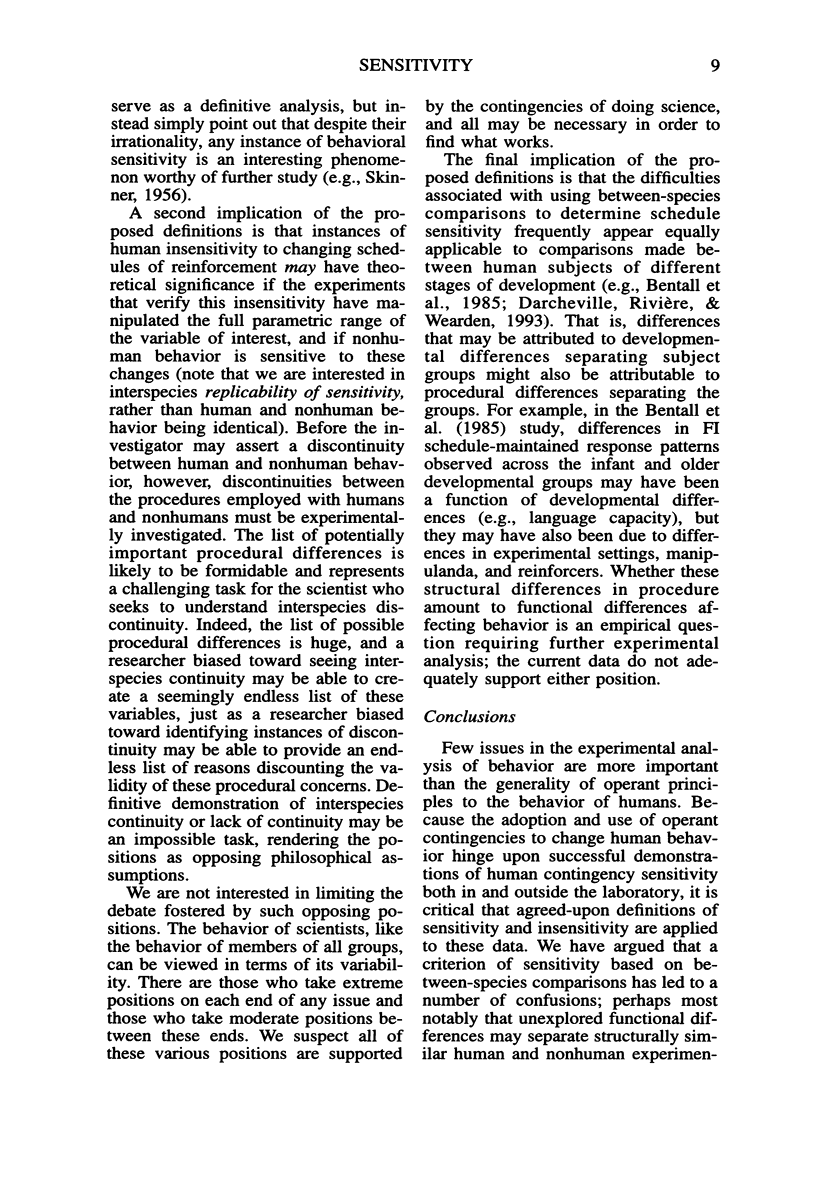
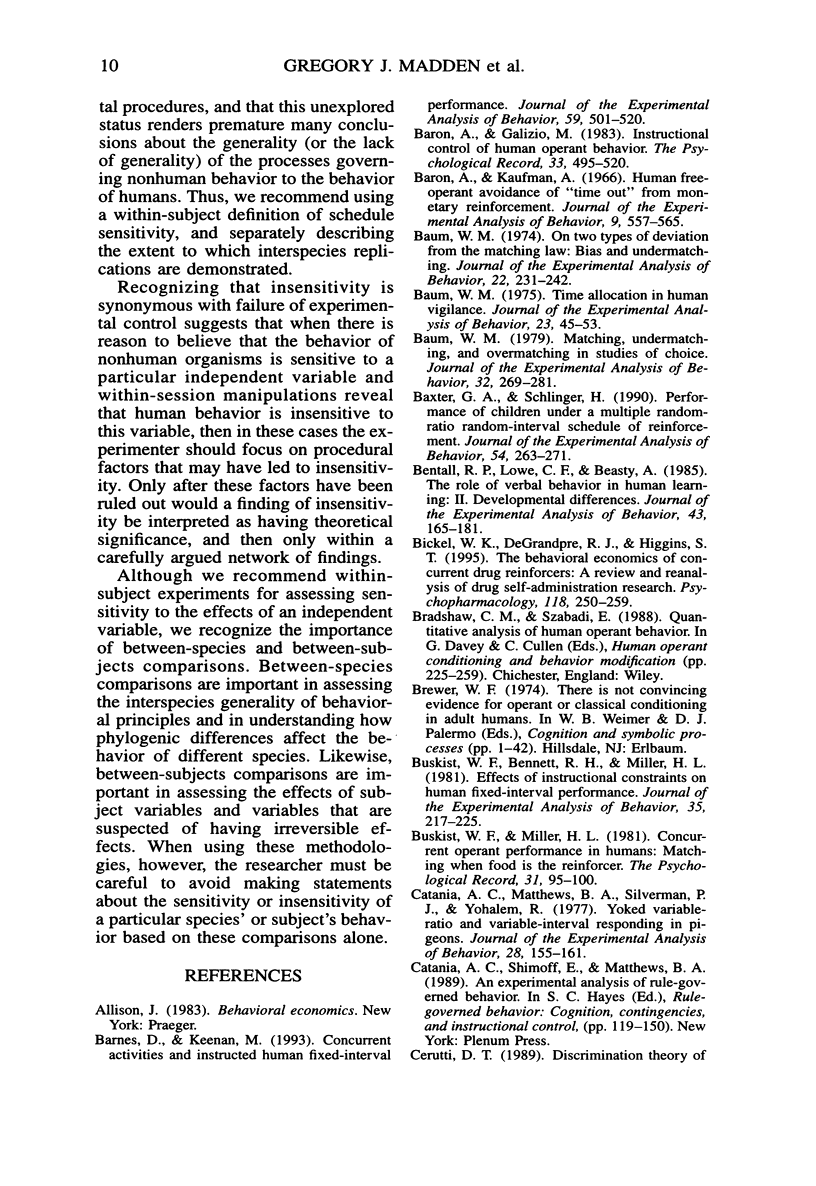
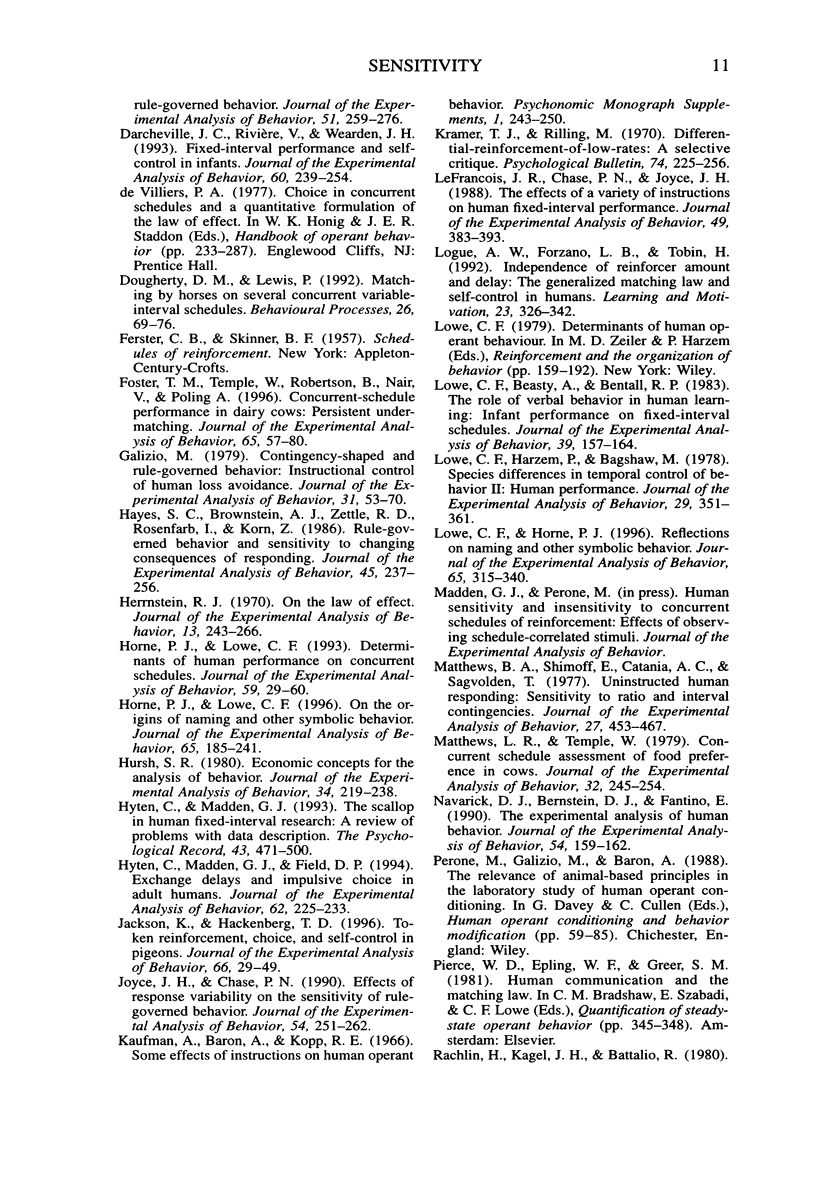
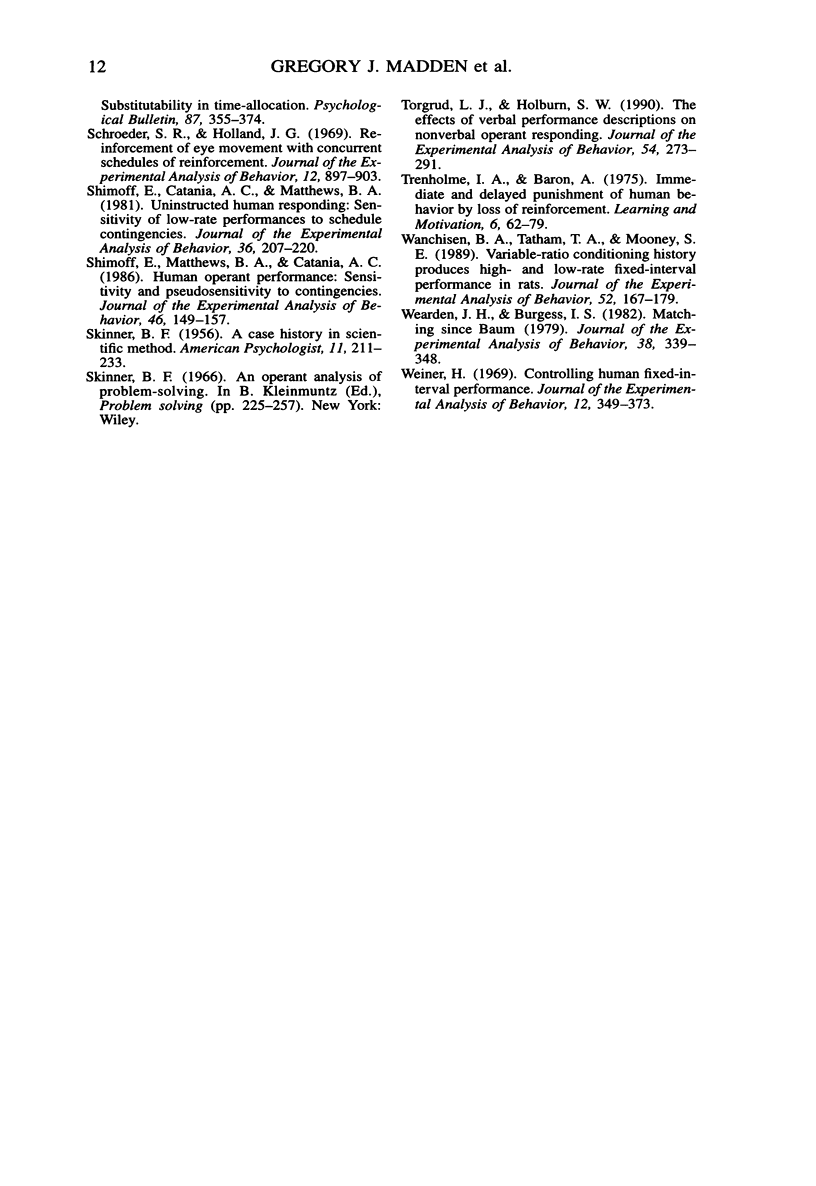
Selected References
These references are in PubMed. This may not be the complete list of references from this article.
- Barnes D., Keenan M. Concurrent activities and instructed human fixed-interval performance. J Exp Anal Behav. 1993 May;59(3):501–520. doi: 10.1901/jeab.1993.59-501. [DOI] [PMC free article] [PubMed] [Google Scholar]
- Baron A., Kaufman A. Human, free-operant avoidance of "time out" from monetary reinforcement. J Exp Anal Behav. 1966 Sep;9(5):557–565. doi: 10.1901/jeab.1966.9-557. [DOI] [PMC free article] [PubMed] [Google Scholar]
- Baum W. M. Matching, undermatching, and overmatching in studies of choice. J Exp Anal Behav. 1979 Sep;32(2):269–281. doi: 10.1901/jeab.1979.32-269. [DOI] [PMC free article] [PubMed] [Google Scholar]
- Baum W. M. On two types of deviation from the matching law: bias and undermatching. J Exp Anal Behav. 1974 Jul;22(1):231–242. doi: 10.1901/jeab.1974.22-231. [DOI] [PMC free article] [PubMed] [Google Scholar]
- Baum W. M. Time allocation in human vigilance. J Exp Anal Behav. 1975 Jan;23(1):45–53. doi: 10.1901/jeab.1975.23-45. [DOI] [PMC free article] [PubMed] [Google Scholar]
- Baxter G. A., Schlinger H. Performance of children under a multiple random-ratio random-interval schedule of reinforcement. J Exp Anal Behav. 1990 Nov;54(3):263–271. doi: 10.1901/jeab.1990.54-263. [DOI] [PMC free article] [PubMed] [Google Scholar]
- Bentall R. P., Lowe C. F., Beasty A. The role of verbal behavior in human learning: II. Developmental differences. J Exp Anal Behav. 1985 Mar;43(2):165–181. doi: 10.1901/jeab.1985.43-165. [DOI] [PMC free article] [PubMed] [Google Scholar]
- Bickel W. K., DeGrandpre R. J., Higgins S. T. The behavioral economics of concurrent drug reinforcers: a review and reanalysis of drug self-administration research. Psychopharmacology (Berl) 1995 Apr;118(3):250–259. doi: 10.1007/BF02245952. [DOI] [PubMed] [Google Scholar]
- Buskist W. F., Bennett R. H., Miller H. L. Effects of instructional constraints on human fixed-interval performance. J Exp Anal Behav. 1981 Mar;35(2):217–225. doi: 10.1901/jeab.1981.35-217. [DOI] [PMC free article] [PubMed] [Google Scholar]
- Catania A. C., Matthews T. J., Silverman P. J., Yohalem R. Yoked variable-ratio and variable-interval responding in pigeons. J Exp Anal Behav. 1977 Sep;28(2):155–161. doi: 10.1901/jeab.1977.28-155. [DOI] [PMC free article] [PubMed] [Google Scholar]
- Cerutti D. T. Discrimination theory of rule-governed behavior. J Exp Anal Behav. 1989 Mar;51(2):259–276. doi: 10.1901/jeab.1989.51-259. [DOI] [PMC free article] [PubMed] [Google Scholar]
- Darcheville J. C., Rivière V., Wearden J. H. Fixed-interval performance and self-control in infants. J Exp Anal Behav. 1993 Sep;60(2):239–254. doi: 10.1901/jeab.1993.60-239. [DOI] [PMC free article] [PubMed] [Google Scholar]
- Foster T. M., Temple W., Robertson B., Nair V., Poling A. Concurrent-schedule performance in dairy cows: persistent undermatching. J Exp Anal Behav. 1996 Jan;65(1):57–80. doi: 10.1901/jeab.1996.65-57. [DOI] [PMC free article] [PubMed] [Google Scholar]
- Galizio M. Contingency-shaped and rule-governed behavior: instructional control of human loss avoidance. J Exp Anal Behav. 1979 Jan;31(1):53–70. doi: 10.1901/jeab.1979.31-53. [DOI] [PMC free article] [PubMed] [Google Scholar]
- Hayes S. C., Brownstein A. J., Zettle R. D., Rosenfarb I., Korn Z. Rule-governed behavior and sensitivity to changing consequences of responding. J Exp Anal Behav. 1986 May;45(3):237–256. doi: 10.1901/jeab.1986.45-237. [DOI] [PMC free article] [PubMed] [Google Scholar]
- Herrnstein R. J. On the law of effect. J Exp Anal Behav. 1970 Mar;13(2):243–266. doi: 10.1901/jeab.1970.13-243. [DOI] [PMC free article] [PubMed] [Google Scholar]
- Horne P. J., Lowe C. F. Determinants of human performance on concurrent schedules. J Exp Anal Behav. 1993 Jan;59(1):29–60. doi: 10.1901/jeab.1993.59-29. [DOI] [PMC free article] [PubMed] [Google Scholar]
- Horne P. J., Lowe C. F. On the origins of naming and other symbolic behavior. J Exp Anal Behav. 1996 Jan;65(1):185–241. doi: 10.1901/jeab.1996.65-185. [DOI] [PMC free article] [PubMed] [Google Scholar]
- Hursh S. R. Economic concepts for the analysis of behavior. J Exp Anal Behav. 1980 Sep;34(2):219–238. doi: 10.1901/jeab.1980.34-219. [DOI] [PMC free article] [PubMed] [Google Scholar]
- Hyten C., Madden G. J., Field D. P. Exchange delays and impulsive choice in adult humans. J Exp Anal Behav. 1994 Sep;62(2):225–233. doi: 10.1901/jeab.1994.62-225. [DOI] [PMC free article] [PubMed] [Google Scholar]
- Jackson K., Hackenberg T. D. Token reinforcement, choice, and self-control in pigeons. J Exp Anal Behav. 1996 Jul;66(1):29–49. doi: 10.1901/jeab.1996.66-29. [DOI] [PMC free article] [PubMed] [Google Scholar]
- Joyce J. H., Chase P. N. Effects of response variability on the sensitivity of rule-governed behavior. J Exp Anal Behav. 1990 Nov;54(3):251–262. doi: 10.1901/jeab.1990.54-251. [DOI] [PMC free article] [PubMed] [Google Scholar]
- Lefrancois J. R., Chase P. N., Joyce J. H. The effects of a variety of instructions on human fixed-interval performance. J Exp Anal Behav. 1988 May;49(3):383–393. doi: 10.1901/jeab.1988.49-383. [DOI] [PMC free article] [PubMed] [Google Scholar]
- Lowe C. F., Beasty A., Bentall R. P. The role of verbal behavior in human learning: infant performance on fixed-interval schedules. J Exp Anal Behav. 1983 Jan;39(1):157–164. doi: 10.1901/jeab.1983.39-157. [DOI] [PMC free article] [PubMed] [Google Scholar]
- Lowe C. F., Harzem P., Bagshaw M. Species differences in temporal control of behavior II: human performance. J Exp Anal Behav. 1978 May;29(3):351–361. doi: 10.1901/jeab.1978.29-351. [DOI] [PMC free article] [PubMed] [Google Scholar]
- Lowe C. F., Horne P. J. Reflections on naming and other symbolic behavior. J Exp Anal Behav. 1996 Jan;65(1):315–353. doi: 10.1901/jeab.1996.65-315. [DOI] [PMC free article] [PubMed] [Google Scholar]
- Matthews B. A., Shimoff E., Catania A. C., Sagvolden T. Uninstructed human responding: sensitivity to ratio and interval contingencies. J Exp Anal Behav. 1977 May;27(3):453–467. doi: 10.1901/jeab.1977.27-453. [DOI] [PMC free article] [PubMed] [Google Scholar]
- Matthews L. R., Temple W. Concurrent schedule assessment of food preference in cows. J Exp Anal Behav. 1979 Sep;32(2):245–254. doi: 10.1901/jeab.1979.32-245. [DOI] [PMC free article] [PubMed] [Google Scholar]
- Navarick D. J. The experimental analysis of human behavior (Editorial). J Exp Anal Behav. 1990 Nov;54(3):159–162. doi: 10.1901/jeab.1990.54-159. [DOI] [PMC free article] [PubMed] [Google Scholar]
- Schroeder S. R., Holland J. G. Reinforcement of eye movement with concurrent schedules. J Exp Anal Behav. 1969 Nov;12(6):897–903. doi: 10.1901/jeab.1969.12-897. [DOI] [PMC free article] [PubMed] [Google Scholar]
- Shimoff E., Catania A. C., Matthews B. A. Uninstructed human responding: Sensitivity of low-rate performance to schedule contingencies. J Exp Anal Behav. 1981 Sep;36(2):207–220. doi: 10.1901/jeab.1981.36-207. [DOI] [PMC free article] [PubMed] [Google Scholar]
- Shimoff E., Matthews B. A., Catania A. C. Human operant performance: Sensitivity and pseudosensitivity to contingencies. J Exp Anal Behav. 1986 Sep;46(2):149–157. doi: 10.1901/jeab.1986.46-149. [DOI] [PMC free article] [PubMed] [Google Scholar]
- Torgrud L. J., Holborn S. W. The effects of verbal performance descriptions on nonverbal operant responding. J Exp Anal Behav. 1990 Nov;54(3):273–291. doi: 10.1901/jeab.1990.54-273. [DOI] [PMC free article] [PubMed] [Google Scholar]
- Wanchisen B. A., Tatham T. A., Mooney S. E. Variable-ratio conditioning history produces high- and low-rate fixed-interval performance in rats. J Exp Anal Behav. 1989 Sep;52(2):167–179. doi: 10.1901/jeab.1989.52-167. [DOI] [PMC free article] [PubMed] [Google Scholar]
- Wearden J. H., Burgess I. S. Matching since Baum (1979). J Exp Anal Behav. 1982 Nov;38(3):339–348. doi: 10.1901/jeab.1982.38-339. [DOI] [PMC free article] [PubMed] [Google Scholar]
- Weiner H. Controlling human fixed-interval performance. J Exp Anal Behav. 1969 May;12(3):349–373. doi: 10.1901/jeab.1969.12-349. [DOI] [PMC free article] [PubMed] [Google Scholar]


